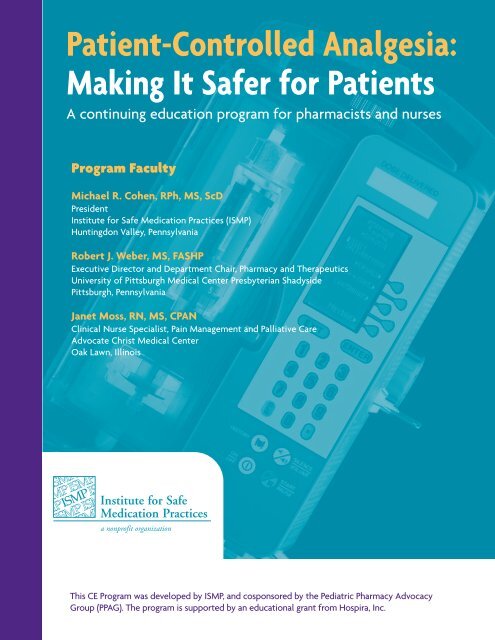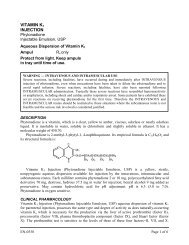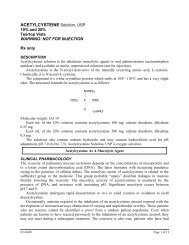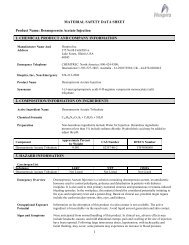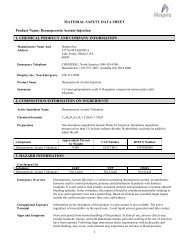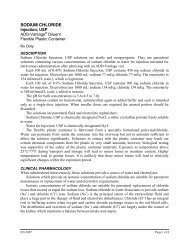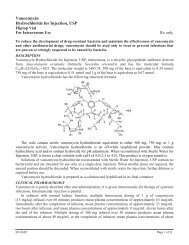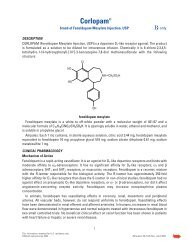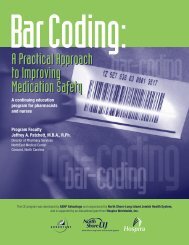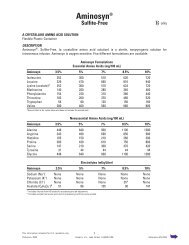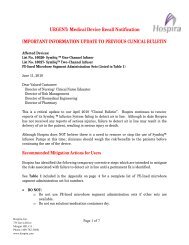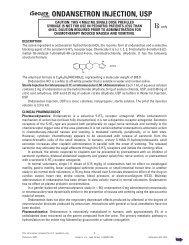Patient-Controlled Analgesia: Making It Safer for Patients - Hospira
Patient-Controlled Analgesia: Making It Safer for Patients - Hospira
Patient-Controlled Analgesia: Making It Safer for Patients - Hospira
Create successful ePaper yourself
Turn your PDF publications into a flip-book with our unique Google optimized e-Paper software.
<strong>Patient</strong>-<strong>Controlled</strong> <strong>Analgesia</strong>:<br />
<strong>Making</strong> <strong>It</strong> <strong>Safer</strong> <strong>for</strong> <strong>Patient</strong>s<br />
A continuing education program <strong>for</strong> pharmacists and nurses<br />
Program Faculty<br />
Michael R. Cohen, RPh, MS, ScD<br />
President<br />
Institute <strong>for</strong> Safe Medication Practices (ISMP)<br />
Huntingdon Valley, Pennsylvania<br />
Robert J. Weber, MS, FASHP<br />
Executive Director and Department Chair, Pharmacy and Therapeutics<br />
University of Pittsburgh Medical Center Presbyterian Shadyside<br />
Pittsburgh, Pennsylvania<br />
Janet Moss, RN, MS, CPAN<br />
Clinical Nurse Specialist, Pain Management and Palliative Care<br />
Advocate Christ Medical Center<br />
Oak Lawn, Illinois<br />
ISMPI<br />
MPISMP<br />
MPIS<br />
ISMP MPISM<br />
ISMP ISMP<br />
ISMP<br />
This CE Program was developed by ISMP, and cosponsored by the Pediatric Pharmacy Advocacy<br />
Group (PPAG). The program is supported by an educational grant from <strong>Hospira</strong>, Inc.
Learning Objectives<br />
After studying this monograph, the reader should be able to:<br />
• Identify common safety issues related to use of patient-controlled analgesia (PCA).<br />
• Design appropriate patient selection criteria <strong>for</strong> PCA use.<br />
• Develop standard PCA prescribing and monitoring practices.<br />
• Communicate the need <strong>for</strong> an interdisciplinary approach to prevent patient harm.<br />
• Use a standardized process to evaluate the safety of PCA products or devices.<br />
Pharmacy Continuing Education In<strong>for</strong>mation<br />
Continuing education (CE) credit will be provided by the Pediatric Pharmacy Advocacy<br />
Group (PPAG). PPAG is an approved provider of continuing pharmacy education by the<br />
Accreditation Council <strong>for</strong> Pharmacy Education. The program (180-999-05-502-L01) is<br />
approved <strong>for</strong> 1.5 contact hours (.15 CEUs) of CE credit, and is provided free of charge. Pharmacists<br />
who complete the program may take the test and print their CE statements from the ISMP website<br />
(www.ismp.org/ce/default.asp). The release date of this program is April 1, 2006 and the expiration<br />
date is April 1, 2009.<br />
Nursing Continuing Education<br />
Debora Simmons is approved by the Cali<strong>for</strong>nia Board of Nurse Examiners as a provider of continuing<br />
nursing education. This program (number CEP 13677) is approved <strong>for</strong> 1.0 contact hours (0.1 CEUs)<br />
of continuing nursing education. Nurses who complete the program may take the test and print<br />
their CE statements from the ISMP website (www.ismp.org/ce/default.asp). The release date of this<br />
program is April 1, 2006 and the expiration date is April 1, 2009.<br />
DISCLOSURE STATEMENTS<br />
<strong>It</strong> is the policy of PPAG to insure independence, balance, objectivity, and scientific rigor in all its individually or<br />
jointly presented education programs. All faculty participating in PPAG programs are expected to disclose any real or<br />
apparent conflict(s) of interest that may have a direct or indirect bearing on the subject matter of the continuing<br />
education program. Disclosure pertains to relationships with any pharmaceutical companies, biomedical device<br />
manufacturers, or other corporations whose products or services are related or unrelated to the subject matter of<br />
your presentation topic. As of the program release date, none of the faculty had any conflicts to report.
<strong>Patient</strong>-<strong>Controlled</strong> <strong>Analgesia</strong>:<br />
<strong>Making</strong> <strong>It</strong> <strong>Safer</strong> <strong>for</strong> <strong>Patient</strong>s<br />
Safety Issues Associated with<br />
<strong>Patient</strong>-<strong>Controlled</strong> <strong>Analgesia</strong><br />
Michael R. Cohen, RPh, MS, ScD<br />
President<br />
Institute <strong>for</strong> Safe Medication Practices (ISMP)<br />
Huntingdon Valley, Pennsylvania<br />
The benefits of patient-controlled analgesia (PCA) are well<br />
known. Prior to the adoption of PCA, pain was alleviated<br />
by administering frequent, intermittent bolus doses of narcotic<br />
analgesics, and patients often complained about the number<br />
of injections required. Occasionally oral tablets were<br />
administered, but their effectiveness was questionable due<br />
to decreased absorption. In addition, pain management teams<br />
did not exist and pain control was not considered as high a<br />
priority as it is today. <strong>Patient</strong>s could only ask a nurse <strong>for</strong> pain<br />
medication, and sometimes there would be significant delays<br />
in administration while the order was checked and the<br />
medication was obtained and prepared.<br />
PCA is an effective method <strong>for</strong> administering opiates to<br />
patients <strong>for</strong> pain relief, and gives patients a sense of control<br />
over their pain. However, based on the in<strong>for</strong>mation submitted<br />
to the United States Pharmacopeia–ISMP Medication Errors<br />
Reporting Program (USP-ISMP MERP), it is clear that there are<br />
problems associated with PCA. These problems will be examined<br />
in detail in this review. Please note that you can report<br />
medication errors to USP-ISMP MERP by calling 1-800-FAIL-SAFE<br />
or online at www.ismp.org.<br />
PCA by Proxy<br />
PCA is intended to be patient-controlled analgesia. Probably<br />
the most tragic error or event associated with PCA involves<br />
what is referred to as PCA by proxy, where someone other<br />
than the patient presses the button to inject a dose of pain<br />
medication into the patient. A very important safety feature of<br />
PCA is that patients who are oversedated from having received<br />
too much opiate will not be able to press the button to obtain<br />
additional doses of the drug. This safety feature is overridden if<br />
someone else pushes the button <strong>for</strong> them.<br />
Family members may believe that they are helping the patient<br />
remain pain-free by pushing the button <strong>for</strong> them. When other<br />
individuals push the PCA button, they may seriously misjudge<br />
the patient’s level of sedation, resulting in extreme oversedation,<br />
respiratory depression, and potential respiratory arrest.<br />
When other individuals push the PCA<br />
button, they may seriously misjudge the<br />
patient’s level of sedation, resulting in<br />
extreme oversedation and<br />
respiratory depression.<br />
Like many medication errors, the exact incidence of PCA by<br />
proxy is unknown. The difficulty in determining an overall<br />
frequency of the problem is that the numerator and denominator<br />
are not known because the exact number of PCA prescriptions<br />
is not available. However, it is clear that this practice has<br />
led to fatal incidents.<br />
ISMP has investigated several error reports involving PCA, including<br />
one involving an otherwise healthy teenage girl who died<br />
when her PCA button was pushed continuously by her mother.<br />
As a result of incidents such as this, there has been a call <strong>for</strong><br />
action regarding PCA by proxy. At a minimum, there should be<br />
hazard warnings on the PCA equipment to caution family<br />
members and even health care practitioners about the dangers<br />
of PCA by proxy. Family members and medical staff should also<br />
be provided with education and training on proper PCA use.<br />
PCA by proxy may be legitimately used by nurses in certain situations,<br />
but it is probably more appropriate to call this practice<br />
nurse-assisted analgesic dosing. Nurse-assisted analgesic dosing<br />
can be used safely when the healthcare professionals involved<br />
are authorized, properly educated on pain assessment and<br />
opioid toxicity, and required to follow a protocol.<br />
Unauthorized PCA by proxy involving a spouse, family member,<br />
or friend is far more likely to result in patient harm. Other<br />
<strong>Patient</strong>-<strong>Controlled</strong> <strong>Analgesia</strong>: <strong>Making</strong> <strong>It</strong> <strong>Safer</strong> <strong>for</strong> <strong>Patient</strong>s 1
y proxy situations may be more controversial, such as when<br />
parents control the administration of the drug by pushing the<br />
button <strong>for</strong> their child. Many children can be taught to use PCA,<br />
and although healthcare organizations may elect to have an<br />
age limit <strong>for</strong> this method of pain management, each case<br />
should be evaluated individually. Hospitals should develop<br />
policies and procedures to address family and nurse<br />
administration of PCA.<br />
<strong>Patient</strong> Selection<br />
Another significant problem is improper patient selection. The<br />
obvious benefits of PCA have led providers to extend its use to<br />
less than ideal candidates, such as infants, young children, and<br />
confused elderly patients. When less than ideal candidates<br />
are selected, the incidence of PCA by proxy may increase.<br />
<strong>Patient</strong>s must be cognitively, physically, and psychologically<br />
capable of understanding the concepts of PCA and handling<br />
the procedure necessary to obtain pain relief. This frequently<br />
may rule out the use of PCA in many pediatric and confused<br />
elderly patients. Less than ideal candidates also include those<br />
at risk <strong>for</strong> respiratory depression due to comorbid conditions<br />
such as obesity, asthma, or sleep apnea, or use of concurrent<br />
drugs that potentiate opiates.<br />
<strong>Patient</strong> Monitoring<br />
Inadequate patient assessment and monitoring of patients using<br />
PCA also is a source of potential errors. Un<strong>for</strong>tunately, standard<br />
methods <strong>for</strong> assessing level of consciousness do not take into<br />
consideration that overly sedated patients can be aroused and<br />
respond to questions. Even though these patients can be<br />
aroused <strong>for</strong> a brief period of time and may in fact be able to<br />
speak, they immediately fall back into a state of oversedation<br />
when the stimulus is removed. In addition, an overly sedated<br />
patient’s respiratory rate may improve with stimulation but<br />
quickly decreases when the stimulation is removed.<br />
A proper assessment is first per<strong>for</strong>med by observation without<br />
stimulation, so that quality or depth of respirations as well as<br />
respiratory rate can be evaluated. Pain management teams<br />
should develop a standard sedation scale that is used throughout<br />
the organization <strong>for</strong> monitoring and documenting the level<br />
of patient sedation.<br />
There are risk factors that can predict the potential <strong>for</strong> respiratory<br />
depression in patients using PCA, such as obesity, asthma,<br />
sleep apnea, and use of drugs that may potentiate opiates. The<br />
use of pulse oximetry as a monitoring tool is becoming more<br />
prevalent and the use of capnography is gaining favor as well.<br />
Capnography measures the end tidal volume of carbon dioxide,<br />
which is a more reliable indicator of respiratory depression<br />
2 <strong>Patient</strong>-<strong>Controlled</strong> <strong>Analgesia</strong>: <strong>Making</strong> <strong>It</strong> <strong>Safer</strong> <strong>for</strong> <strong>Patient</strong>s<br />
and has previously been employed in limited areas such as<br />
critical care units.<br />
<strong>Patient</strong> Education<br />
The lack of effective patient education is a factor in many<br />
errors with PCA. <strong>Patient</strong> teaching is often non-existent or<br />
inadequate. <strong>Patient</strong>s who are candidates <strong>for</strong> post-surgical use<br />
of PCA should be trained prior to admission <strong>for</strong> their surgery.<br />
However, many patients only learn about PCA when they<br />
awaken from anesthesia and a nurse in the post-anesthesia care<br />
unit is explaining it to them <strong>for</strong> the first time. As part of the<br />
pre-admission process, patients and their families must be<br />
taught the relationship between pain, pushing the button, and<br />
adequate pain relief. They should understand the benefits of<br />
PCA and how it works. They also should be shown that the<br />
pain control button differs in appearance from the nurse call<br />
button.<br />
Un<strong>for</strong>tunately, some patients and/or their families misunderstand<br />
instructions and believe that they must push the PCA<br />
button as often as possible. In one report submitted to ISMP,<br />
a patient’s husband thought that his wife must push the PCA<br />
button every 6 minutes. Of course, what was really meant was<br />
that if the pain persisted, she could push the PCA button every<br />
6 minutes.<br />
Nomenclature<br />
Drug name mix-ups have contributed to medication errors<br />
with PCA. <strong>It</strong> is not uncommon <strong>for</strong> practitioners to confuse<br />
hydromorphone and morphine. ISMP and ISMP Canada have<br />
investigated many error reports where these two drugs have<br />
been confused with each other—in at least one case, the<br />
mix-up resulted in the death of a patient.<br />
Recommendations <strong>for</strong> preventing these errors include using<br />
auxiliary warning labels to alert staff that there is a potential<br />
<strong>for</strong> confusion and storing the drugs separate from each other<br />
and using tall man (upper case) letters to distinguish<br />
HYDROmorphone from morphine. Using bar coding technology<br />
also can help reduce the potential <strong>for</strong> drug mix-ups.<br />
Drug Shortages<br />
Drug shortages can also cause problems because they often<br />
result in non-standard drugs and concentrations being used in<br />
place of those that are well known to staff members. For example,<br />
during a period of time in which fentanyl was unavailable in<br />
the marketplace, many organizations switched to Sufentanil.<br />
Sufentanil is much more potent than fentanyl and errors were<br />
made by programming infusion pumps based on fentanyl<br />
dosing, which resulted in the patient receiving too much drug.
Practice-Related Problems<br />
Inadvertent misprogramming of infusion pumps also can result<br />
in over- or under-dosing (see figure 1). Errors occur when<br />
clinicians choose the wrong pre-programmed drug or concentration;<br />
<strong>for</strong> example, they may select a 0.01 mg bolus versus a<br />
0.1 mg bolus, or select 1 mg/mL as the concentration when it is<br />
the 5 mg/mL product they are using. Or they may select the<br />
wrong lockout settings or dose limits. The terms milliliter<br />
and milligram also have been confused; <strong>for</strong> this reason, ISMP<br />
promotes expressing milliliter as mL with an upper case “L.”<br />
FIGURE 1. HUMAN FACTORS/DESIGN FLAWS WITH PCA.<br />
• 10-fold rate-setting errors (10 vs 1.0 vs 0.1 mg)<br />
• mL vs mg confusion<br />
• Difficulty in standardizing pumps (multiple types used by<br />
same organization)<br />
• Insufficient hazard warnings on equipment to prevent PCA<br />
by proxy and device-specific errors<br />
• Battery failures<br />
• Prefilled syringe labels not readable once in pump<br />
• PCA cord confused with patient call bell<br />
• Drug security issues with manipulation of plunger and<br />
ability to open door without key<br />
Other errors that have occurred include the PCA dose being<br />
confused with the basal rate or dose and frequency being mistaken<br />
<strong>for</strong> one another. Error reports have been received stating<br />
that the basal rate was inadvertently continued during surgery<br />
when it was intended to be stopped until after the surgical<br />
procedure. In some cases, the loading dose was programmed<br />
where the basal dose should have been entered. Other reports<br />
identify calculation errors and keying errors made when entering<br />
the prescription order into the infusion pump. The failure<br />
to document key patient in<strong>for</strong>mation, such as drug allergies<br />
and opiate antagonist misuse, also has been identified as a<br />
factor contributing to medication errors with PCA.<br />
To prevent these problems, independent double checks of the<br />
rate, concentration and dose settings as well as identification<br />
of the correct infusion line are recommended when PCA is<br />
initiated or if a rate change requires a change in programming<br />
of the infusion pump. Infusion pumps that have barcode technology<br />
and contain drug libraries with maximum established<br />
administration rates can help trap programming errors.<br />
Protocols and standard order sets and the development of a<br />
reference sheet with programming tips and maximum dose<br />
in<strong>for</strong>mation also are helpful. The purchase of prefilled syringes<br />
containing the drugs used <strong>for</strong> PCA can help to reduce the<br />
number of dispensing errors as well.<br />
Equipment Problems<br />
Equipment-related errors can occur with PCA. Infusion lines<br />
have been connected or reconnected incorrectly. Using two<br />
different PCA pumps in the same institution has resulted in<br />
errors due to equipment mix-ups. Occasionally clinicians have<br />
even failed to remember to push the start button to begin the<br />
infusion after it is set up. <strong>Patient</strong>s also have confused the nurse<br />
call button with the button on the infusion pump that is<br />
pressed to administer a dose of analgesia. This mistake results<br />
in failure to administer a dose when patients thought they<br />
were requesting one or administering an unintended dose<br />
when they thought they were calling <strong>for</strong> a nurse. Other problems<br />
that can contribute to errors include battery failures and<br />
syringe positioning that prevents the drug name on the label<br />
from being visible once it is inserted.<br />
Prescribing<br />
The prescription <strong>for</strong> PCA can itself be a source of errors.<br />
Mistakes have been made when converting the dose from the<br />
oral to the intravenous <strong>for</strong>m of hydromorphone. Verbal orders<br />
<strong>for</strong> PCA and poor handwriting have led to misinterpretation.<br />
Occasionally PCA has been ordered <strong>for</strong> a patient who still had<br />
an active order <strong>for</strong> another opiate that was being given orally<br />
or intravenously, and that order was not discontinued, resulting<br />
in additional opiates being administered.<br />
Staff Education<br />
Staff education is crucial to the success and safety of PCA.<br />
Un<strong>for</strong>tunately, physician and staff credentialing <strong>for</strong> PCA is<br />
uncommon. Staff education must cover several key areas,<br />
including interpreting the prescription order, proper entry of<br />
the in<strong>for</strong>mation into the infusion delivery device, educating the<br />
patient and family members, and effective patient monitoring<br />
and documentation.<br />
Educational Tools<br />
After reviewing input received from several experts, The Joint<br />
Commission on Accreditation of Healthcare Organizations<br />
(JCAHO) has published on their website a sentinel event alert<br />
regarding PCA. The in<strong>for</strong>mation presented may be helpful to<br />
organizations in the development of policies and procedures.<br />
The alert can be found in the sentinel event section of JCAHO’s<br />
website (www.jointcommission.org); click on the December 20,<br />
2004 issue. On ISMP’s website, practitioners can find a patient<br />
safety video produced by the Food and Drug Administration<br />
(FDA) that addresses safety issues with PCA. To view the video,<br />
go to www.ismp.org/Tools/fdavideos.asp, and click on the link<br />
<strong>for</strong> August 2002. ■<br />
<strong>Patient</strong>-<strong>Controlled</strong> <strong>Analgesia</strong>: <strong>Making</strong> <strong>It</strong> <strong>Safer</strong> <strong>for</strong> <strong>Patient</strong>s 3
Developing Quality Indicators<br />
<strong>for</strong> <strong>Patient</strong>-<strong>Controlled</strong><br />
<strong>Analgesia</strong><br />
Robert J. Weber, MS, FASHP<br />
Executive Director and Department Chair,<br />
Pharmacy and Therapeutics<br />
University of Pittsburgh Medical Center<br />
Presbyterian Shadyside<br />
Pittsburgh, Pennsylvania<br />
<strong>Patient</strong> safety is an area of significant concern with patientcontrolled<br />
analgesia (PCA) because serious errors have<br />
occurred when PCA has been employed. According to an<br />
analysis of national error data from the MEDMARX database,<br />
opiates represent one of the four drug categories that cause<br />
more than 60% of serious adverse events in the United States<br />
(the others are anticoagulants, insulin, and antibiotics).*<br />
However, safe practices can be developed <strong>for</strong> PCA, and quality<br />
indicators established to monitor these practices. <strong>It</strong> is important<br />
to understand that evaluating quality is difficult unless one can<br />
measure a baseline prior to the implementation of the identified<br />
safety practices. This article will address how to create a<br />
successful quality improvement initiative and measure results.<br />
Opiates represent one of the four drug<br />
categories that cause more than 60% of<br />
serious adverse events in the United States<br />
(the others are anticoagulants, insulin,<br />
and antibiotics).<br />
Involving Stakeholders<br />
Key stakeholders must be involved at the start of any ef<strong>for</strong>t<br />
to improve safety and quality. Members of the Pittsburgh<br />
Regional Health Initiative (PRHI) have discovered that the<br />
most important person linked to the success of patient safety<br />
initiatives is the physician. The Pittsburgh group has concluded<br />
that success is not possible without a physician champion<br />
who feels passionately about the initiative and is willing to<br />
tackle any barrier in the organization to achieve successful<br />
* An analysis of regional and national MEDMARX data was per<strong>for</strong>med in July<br />
2004 by Robert Weber and the University of Pittsburgh School of Pharmacy Data<br />
Coordinating Center as part of the Pennsylvania Regional Health Initiative (PRHI).<br />
4 <strong>Patient</strong>-<strong>Controlled</strong> <strong>Analgesia</strong>: <strong>Making</strong> <strong>It</strong> <strong>Safer</strong> <strong>for</strong> <strong>Patient</strong>s<br />
implementation. Other key elements are support from the<br />
chief executive officer, simplification of processes, and staff<br />
management of the program 24 hours a day, 7 days a week.<br />
The PRHI also has identified several common roadblocks to<br />
implementing a patient safety initiative and effectively measuring<br />
the resulting improvement in quality. If staff believe that<br />
they are not empowered to actually effect change, it can be<br />
difficult to get a patient safety initiative off the ground. In<br />
addition, some clinicians have inertia of previous practice—<br />
defined as the attitude “that is how we have always done it”—<br />
which also can quickly derail an initiative. <strong>It</strong> is important<br />
to determine whether these potential barriers are present at<br />
the start, so that they can be taken into account during the<br />
planning stages.<br />
Using Reporting Systems<br />
Medication error reporting programs can be a valuable part<br />
of the quality improvement process, as long as the data<br />
obtained is converted into learning. In order to improve safety,<br />
the healthcare culture must be changed, medication error<br />
reporting programs put into place, the data analyzed, and<br />
evidence-based interventions implemented. Only then a<br />
quality improvement process can be put in place to measure<br />
change from a baseline.<br />
The PRHI has collected data on serious medication errors<br />
resulting in harm and requiring additional patient treatment.<br />
Opiates were one of the most common drug classes involved,<br />
and nearly 50% of the errors involving opiates were related to<br />
PCA.* This data demonstrates that while PCA provides significant<br />
benefits, it is associated with significant risks. The first<br />
step of the quality improvement process is to find a process to<br />
improve, and there is certainly enough data to show that PCA<br />
is in need of attention.<br />
Developing Quality Indicators<br />
Once problematic processes have been identified, the next<br />
steps are to quantify the problems associated with those<br />
processes and then develop quality indicators <strong>for</strong> them. Simple<br />
and clear quality improvement indicators provide rich data that<br />
can be used extensively within an organization to improve the<br />
quality of care. Developing those indicators can seem like a<br />
daunting task, but in reality it is not difficult.<br />
The easiest way to get things underway is to obtain consensus<br />
opinions from hospital staff. The Pharmacy and Therapeutics<br />
Committee or the Pain Management Committee can identify<br />
the practices that should be implemented in the organization<br />
and their appropriate quality indicators. The key is to remain<br />
focused and to realize that not every indicator has to be
measured. For example, if the group identifies six safe practices<br />
<strong>for</strong> PCA, then decide how many of those should be studied.<br />
I recommend that organizations just starting out with quality<br />
improvement choose two or three to study <strong>for</strong> one year, focus<br />
on making improvements around those indicators, and then<br />
move on to some of the others on the list.<br />
As part of the PRHI, it was useful to bring clinicians together<br />
to discuss the best medical evidence and <strong>for</strong>m a consensus<br />
opinion on the safe practices <strong>for</strong> PCA. Having consensus on the<br />
safe practices and the indicators selected helped prevent or<br />
defuse disagreements that arose when quality improvement<br />
results begin to appear. Members of the PRHI group asked<br />
themselves “How do we create the safest patient environment<br />
with PCA?” and “What practices should be implemented?”<br />
They then developed 26 safe practices <strong>for</strong> PCA, which<br />
eventually were honed down to ten.<br />
A few of the safe practices recommended by members of the<br />
PRHI were:<br />
1) Preprinted order <strong>for</strong>ms (were being used <strong>for</strong> new PCA orders,<br />
but not after dose changes, which resulted in dosage errors)<br />
2) Independent checks<br />
3) Standard parameters <strong>for</strong> monitoring<br />
4) Standard concentration<br />
5) Removing meperidine from the <strong>for</strong>mulary<br />
Measuring Outcomes<br />
When measuring outcomes, you must first decide whether to<br />
measure a process outcome or a clinical outcome. Process<br />
outcomes measure the efficiency of a system, how well the<br />
system is functioning, or compliance with a process, so they<br />
are merely indicators of how well the system is working. <strong>It</strong> is<br />
easier to measure a process outcome, but the data may not be<br />
as valuable. A clinical outcome measures the results of patient<br />
treatment. An example of a process outcome is compliance<br />
with using a preprinted order <strong>for</strong>m <strong>for</strong> PCA. An example of a<br />
clinical outcome is the following statement: “<strong>Patient</strong>s will<br />
report a pain scale of less than (a number defined by your<br />
organization), concomitant with an acceptable sedation level<br />
evaluation.”<br />
An important question to ask when developing an outcome<br />
measurement strategy may be “What is the most crucial<br />
indicator or clinical outcome in PCA?” One of the most crucial<br />
outcomes to avoid in patient care is the adverse drug event.<br />
There<strong>for</strong>e, an extremely useful indicator is measuring the<br />
incidence of adverse drug events associated with PCA. Once<br />
you identify the indicators that you wish to follow, you must<br />
develop a method <strong>for</strong> monitoring them.<br />
An important question to ask when<br />
developing an outcome measurement<br />
strategy may be “What is the most crucial<br />
indicator or clinical outcome in PCA?”<br />
The creation of a table that displays the indicator, the data<br />
source, how the indicator will be measured, and how often it<br />
will be measured is a good way to track your progress. A<br />
sample is provided in figure 1. Understanding the data and<br />
being able to articulate results can help promote the understanding<br />
that a practice improves quality of care. For example,<br />
evidence that a percentage of a healthcare organization’s errors<br />
result from dose changes can help explain to staff why it is<br />
important to use preprinted order <strong>for</strong>ms when doses are<br />
changed, as opposed to using them only at the initiation<br />
of PCA therapy. Showing in reports to staff that the number<br />
of adverse drug events with PCA decreased because of the<br />
implementation of safe practices also will help them<br />
understand the value of quality improvement ef<strong>for</strong>ts.<br />
FIGURE 1. SAMPLE QI TABLE.<br />
Quality Indicators & Data Management<br />
Data Source Measurement Measurement<br />
Scale Frequency<br />
ADEs to PCA Naloxone Review by pain Weekly<br />
usage report, experts, pain<br />
reported team<br />
ADEs<br />
Order <strong>for</strong>m <strong>for</strong> Standing PCA Pharmacist/ Weekly<br />
dosage changes order <strong>for</strong>m, technician review<br />
pharmacy orders of orders<br />
<strong>for</strong> dosage<br />
changes<br />
Tools and Resources<br />
The PRHI has created a PCA toolkit that has been very useful in<br />
implementation of quality improvement ef<strong>for</strong>ts (see figure 2).<br />
The toolkit contains several different aids that assist end users<br />
in knowing how to use PCA safely. Some of the items included<br />
are a pocket pain card, IV guidelines, computer-generated<br />
order <strong>for</strong>ms, posters, and PCA therapy guidelines. The toolkit<br />
also provides the opportunity <strong>for</strong> another quality indicator—<br />
whether staff understand and know how to use these<br />
resources. Another aid to consider developing is a <strong>for</strong>mal<br />
pharmacy competency assessment tool <strong>for</strong> PCA.<br />
<strong>Patient</strong>-<strong>Controlled</strong> <strong>Analgesia</strong>: <strong>Making</strong> <strong>It</strong> <strong>Safer</strong> <strong>for</strong> <strong>Patient</strong>s 5
FIGURE 2. PCA TOOLKIT AND IMPLEMENTATION OVERVIEW.<br />
Components of Successful PCA Safety Initiatives<br />
Staff and <strong>Patient</strong> Education<br />
Written materials<br />
• Pocket pain card<br />
• Regional PCA safety guidelines<br />
• <strong>Patient</strong> education leaflet<br />
Verbal education<br />
• 1:1 education with new residents and pain nurse specialist<br />
• Pharmacy staff inservices<br />
• Pain resource nurse monthly teaching<br />
Electronic access<br />
• Intranet pain card<br />
• Intranet policies<br />
• Online adverse event reporting<br />
• IV guidelines<br />
• Electronic medication administration record (MAR) charting screen<br />
End-User Tools/Processes<br />
• Preprinted PCA order <strong>for</strong>m<br />
• Nursing MAR <strong>for</strong>m<br />
• PCA pendant warning <strong>for</strong> patient safety<br />
• Standard PCA drug concentrations<br />
• Pharmacist rewrite of orders if not on preprinted <strong>for</strong>m<br />
• New PCA pump evaluation <strong>for</strong> health system<br />
Summary<br />
In conclusion, developing quality indicators is not hard—it just<br />
requires common sense. The following are a few key points to<br />
keep in mind when developing quality indicators <strong>for</strong> PCA: focus<br />
on a few specific indicators; utilize experts within the organization<br />
to develop, promote, and track them; create a measurement<br />
process that makes sense and is clear to all involved; and<br />
consider creating and using tool kits to assist staff members<br />
with implementation. ■<br />
6 <strong>Patient</strong>-<strong>Controlled</strong> <strong>Analgesia</strong>: <strong>Making</strong> <strong>It</strong> <strong>Safer</strong> <strong>for</strong> <strong>Patient</strong>s<br />
Failure Mode and Effects<br />
Analysis in Reducing Errors<br />
with <strong>Patient</strong>-<strong>Controlled</strong><br />
<strong>Analgesia</strong><br />
Janet Moss, RN, MS, CPAN<br />
Clinical Nurse Specialist, Pain Management<br />
and Palliative Care<br />
Advocate Christ Medical Center<br />
Oak Lawn, Illinois<br />
The process of Failure Mode Effects Analysis (FMEA)<br />
provides an excellent opportunity to uncover both the<br />
safeguards and risks inherent in the use of patient-controlled<br />
analgesia (PCA). PCA technology has rapidly progressed over<br />
the years, giving clinicians the impression that it is now safer<br />
than ever, even <strong>for</strong> pediatric patients. By participating in FMEA,<br />
practitioners become keenly aware of the potential failures in<br />
their PCA processes. FMEA also offers a clear method <strong>for</strong> identifying<br />
and selecting strategies to reduce the modes of failure.<br />
Many healthcare organizations have chosen to per<strong>for</strong>m FMEA<br />
<strong>for</strong> PCA due to the publication of a Sentinel Event Alert by<br />
the Joint Commission on Accreditation of Healthcare<br />
Organizations (JCAHO). Many hospitals were surprised by the<br />
degree of risk involved after reading the alert and per<strong>for</strong>ming<br />
their own FMEA, especially those that had never experienced<br />
a serious adverse event with PCA.<br />
FMEA is a time-consuming process, sometimes taking several<br />
months to a year. However, because of its proactive nature,<br />
FMEA may be easier to per<strong>for</strong>m than a Root Cause Analysis<br />
(RCA) because there is no “pressure” to find the cause of an<br />
event that has already caused harm to a patient.<br />
FMEA Steps<br />
The steps in the FMEA process are as follows:<br />
1) Select a high-risk process and assemble a team<br />
2) Diagram the process<br />
3) Brainstorm potential failure modes and determine<br />
their effect<br />
4) Prioritize failure modes<br />
5) Identify root causes of failure modes<br />
6) Redesign the process<br />
7) Analyze and test the new process<br />
8) Implement and monitor the new process
Step 1. Select a high-risk process and assemble a team. PCA<br />
is an ideal candidate <strong>for</strong> FMEA due to the high-risk nature of<br />
the medications used. Ideally, the FMEA team will include a<br />
diverse mix of practitioners to offer varying perspectives on<br />
the process and reduce the placing of blame <strong>for</strong> potential<br />
problems identified on any one particular professional group.<br />
For example, a team may consist of individuals from the<br />
following areas:<br />
• Pharmacy<br />
• Nursing<br />
• Per<strong>for</strong>mance improvement<br />
• Risk management<br />
• Medicine<br />
• Biomedical/clinical engineering<br />
• Equipment processing and distribution<br />
Step 2. Diagram the process. This may be the most<br />
challenging step of a FMEA. Many times what seems like a<br />
process of just a few steps actually looks quite complicated<br />
once it is documented in a flowchart. Only after all the steps<br />
are laid out can the brainstorming stage begin. Without a<br />
detailed diagram, potential failure modes could be overlooked<br />
and the opportunity to prevent a failure could be lost. The<br />
team should also include any subprocesses in the flowchart.<br />
Step 3. Brainstorm potential failure modes and determine<br />
their effect. For each step in a process, ask team members to<br />
think of ways that step could fail, causing the PCA process to<br />
reach an undesired outcome or next step (these are the failure<br />
modes). For each failure mode, determine the effect that<br />
failure would have on the process and patient.<br />
Step 4. Prioritize failure modes. The prioritization step can<br />
be made easier by computing a hazard score <strong>for</strong> each failure<br />
mode. Those with highest scores should be considered first<br />
priority <strong>for</strong> analysis and action. Hazard scores are typically<br />
computed by multiplying a severity score by a probability<br />
score. Specific numbers assigned to each score vary by hospital,<br />
but many facilities use the VA National Center <strong>for</strong> <strong>Patient</strong><br />
Safety scoring criteria.<br />
Step 5. Identify root causes of failure modes. The main<br />
question to ask and continue asking is “why?” Only by getting<br />
to the real root cause(s) of a failure mode can appropriate<br />
actions be taken to reduce the severity and probability.<br />
Step 6. Redesign the process. Develop actions to reduce failure<br />
modes by redesigning the process or parts of the process.<br />
Step 7. Analyze and test the new process. This can be accomplished<br />
by piloting the new design first. Then begin a facilitywide<br />
rollout of the redesigned process.<br />
Step 8. Implement and monitor the new process. Choose<br />
measurement indicators to test and analyze the new process.<br />
Choose direct and balancing measures to track effectiveness of<br />
actions.<br />
Be<strong>for</strong>e the patient ever comes in contact<br />
with a drug delivered by a PCA device,<br />
they must first be determined an<br />
appropriate candidate.<br />
Selected Examples<br />
To illustrate FMEA, several processes from an actual FMEA of<br />
PCA are described below.<br />
Process: <strong>Patient</strong> Selection<br />
Be<strong>for</strong>e the patient ever comes in contact with a drug delivered<br />
by a PCA device, they must first be determined an appropriate<br />
candidate. Failures in this process can be stopped be<strong>for</strong>e the<br />
patient can even be put at risk. PCA requires the cooperation<br />
and understanding of the patient—they must have the<br />
physical ability to use the device, the cognitive ability to sense<br />
their level of pain and correctly use the device, and the ability<br />
to understand the directions presented to them. <strong>Patient</strong><br />
characteristics that may preclude someone from being an ideal<br />
candidate, and thus elevate the risk of harm from using PCA,<br />
are if they are confused, have limited dexterity to operate the<br />
pump, have comorbidities that increase the risk of harm from<br />
opioids, or if their primary language is not English.<br />
Even with these exclusionary criteria, PCA may still be prescribed<br />
<strong>for</strong> inappropriate patients. The FMEA team found some<br />
of the root causes (reasons why) to be inaccurate patient<br />
assessment, patient competency bias, and practitioner knowledge<br />
deficit. Practitioners may overestimate a patient’s physical<br />
or cognitive ability and prescribe PCA believing that they are<br />
appropriate <strong>for</strong> the device. They also may determine patient<br />
competency to use a PCA pump without an objective measurement<br />
tool, which brings their own bias into the decision. In<br />
addition, practitioners may not fully understand the patient<br />
selection criteria, intention, and operation of PCA. Pharmacists<br />
in particular may lack this knowledge, making it difficult <strong>for</strong><br />
them to review an order <strong>for</strong> safety if they cannot determine<br />
which patients should and should not be prescribed PCA.<br />
<strong>Patient</strong>-<strong>Controlled</strong> <strong>Analgesia</strong>: <strong>Making</strong> <strong>It</strong> <strong>Safer</strong> <strong>for</strong> <strong>Patient</strong>s 7
To address these potential failures, the FMEA team initiated a<br />
major education campaign <strong>for</strong> all practitioners, especially<br />
pharmacists. This involved developing educational materials<br />
and presentations as well as a competency exam. In addition,<br />
interpreters were used more consistently <strong>for</strong> non-English<br />
speaking patients.<br />
Process: Prescribing<br />
Many parameters must be selected or defined on a prescription<br />
order <strong>for</strong> PCA—such as drug, dosage, and mode—and any<br />
one of them could be a potential chance <strong>for</strong> a mistake. Some<br />
of the root causes behind failures identified by the FMEA team<br />
were practitioner knowledge deficits, incomplete or inaccurate<br />
pain assessments, lack of standardized concentrations, and the<br />
removal of meperidine (Demerol) from the <strong>for</strong>mulary.<br />
Areas where knowledge deficits existed included allergies,<br />
modes of drug delivery, and dangers of nonstandard drug<br />
concentrations. True allergies to morphine are rare, yet many<br />
patient charts have an allergy noted. Morphine is usually the<br />
primary drug <strong>for</strong> PCA—it is safer because the most clinical<br />
knowledge exists about its effects, and most practitioners are<br />
com<strong>for</strong>table prescribing or administering it. If the practitioner<br />
does not know enough about allergies to make further<br />
inquiries about the morphine notation, a secondary drug such<br />
as hydromorphone (Dilaudid) or fentanyl is usually chosen<br />
instead, which places the patient at a greater risk <strong>for</strong> harm.<br />
Lack of knowledge about the mode of PCA drug delivery can<br />
also cause problems. Most PCA devices offer a continuous or<br />
basal rate feature in addition to the patient-activated dose.<br />
Without specialized knowledge about basal or continuous<br />
rates (and a detailed pain treatment history), the ordering of a<br />
basal rate can be error prone and place the patient at a greater<br />
risk <strong>for</strong> opioid toxicity. Basal rates should not be ordered unless<br />
the patient is truly opioid-tolerant, i.e. has a diagnosis of sickle<br />
cell, cancer, or pancreatitis. Many surgical patients are opioidnaïve<br />
and should not receive a basal rate on PCA, which<br />
increases the risk of serious side effects.<br />
Lack of familiarity with nonstandard concentrations was<br />
identified as another potential root cause of prescribing and<br />
administration errors. Sometimes, <strong>for</strong> a reason such as fluid<br />
restriction, a more concentrated <strong>for</strong>m of a drug may be<br />
requested. These nonstandard concentrations are a set up<br />
<strong>for</strong> failures unless every single clinician that may change the<br />
order, adjust the pump, or prepare and dispense the drug is<br />
knowledgeable about them.<br />
8 <strong>Patient</strong>-<strong>Controlled</strong> <strong>Analgesia</strong>: <strong>Making</strong> <strong>It</strong> <strong>Safer</strong> <strong>for</strong> <strong>Patient</strong>s<br />
Incomplete or inaccurate pain assessments were identified as<br />
another source of errors. A complete pain assessment is more<br />
than a numerical rating on a scale. A thorough pain history as<br />
well as assessment of the present episode is necessary to<br />
determine appropriate PCA parameters.<br />
An interesting finding of this FMEA was the unintended<br />
consequence of the removal of meperidine (Demerol) from the<br />
<strong>for</strong>mulary. While standardization is a good thing to prevent<br />
errors, the narrowing of choices created a different potential<br />
root cause. Without the option to order meperidine <strong>for</strong> PCA,<br />
the only options were hydromorphone (Dilaudid) and fentanyl.<br />
Nurses identified a large knowledge deficit with hydromorphone<br />
and fentanyl administration, and thus a subsequent lack<br />
of com<strong>for</strong>t with their use. Nevertheless, leaving meperidine on<br />
the <strong>for</strong>mulary <strong>for</strong> PCA use would have left open the potential<br />
<strong>for</strong> greater patient harm, as it can be a problem when used in<br />
elderly patients with decreased renal function.<br />
To address these root causes, the organization standardized<br />
PCA ordering and PCA drug concentrations. They also required<br />
that pharmacy review all PCA orders be<strong>for</strong>e initiation of therapy<br />
(thereby prohibiting overrides from automated dispensing<br />
cabinets), and embarked on a major educational campaign.<br />
Although the changes were not popular with nurses initially,<br />
they have been accepted over time.<br />
The standardized PCA order <strong>for</strong>m included monitoring parameters,<br />
treatment of side effects, selection of drug (morphine,<br />
hydromorphone, and fentanyl) and mode of device action.<br />
Drug selections were also standardized <strong>for</strong> the concentration<br />
of each IV opioid. At first, the standardized order <strong>for</strong>m was<br />
not consistently used among all prescribers. This prompted a<br />
policy change where PCA orders were accepted only on the<br />
standard <strong>for</strong>m, which facilitated organization-wide acceptance<br />
and use.<br />
Educational methods included a website, pocket reference<br />
cards (see figure 1), pharmacy newsletters, lectures, and competency<br />
exams. The website provided easy access <strong>for</strong> all staff to<br />
topics such as clinical skills, drug and pump in<strong>for</strong>mation, and<br />
how to order PCA, which was helpful <strong>for</strong> new residents. The<br />
PCA pocket cards were tri-fold, yellow cards with in<strong>for</strong>mation<br />
on opioid characteristics and recommended doses. The organization’s<br />
pharmacy newsletters ran in<strong>for</strong>mative articles about<br />
PCA guidelines. In addition, lectures and competency testing<br />
were offered <strong>for</strong> pharmacy and nursing staff.
FIGURE 1. PCA POCKET CARD.<br />
<strong>Patient</strong> <strong>Controlled</strong> <strong>Analgesia</strong> (PCA) <strong>for</strong> Adults<br />
OPIOID SIDE EFFECTS ADVANTAGES DISADVANTAGES CAUTIONS/<br />
CONTRAINDICATIONS<br />
MORPHINE Nausea Vast clinical Slow onset: ~ 15 min. Allergy (use fentanyl)<br />
Sedation experience Histamine release Renal dysfunction<br />
Pruritis Less expensive than Active metabolite Hepatic dysfunction<br />
Reduced peristalsis other opioids (M6G) accumulates in Asthma (histamine<br />
Respiratory depression renal patients & causes<br />
excessive sedation<br />
& other side effects<br />
release)<br />
HYDROMORPHONE Nausea Faster onset than More expensive than Allergy (use fentanyl)<br />
(Dilaudid) Sedation morphine morphine High doses can result<br />
Pruritis Less sedation Less clinical experience in excitation with<br />
Reduced peristalsis No active metabolites than morphine impaired renal<br />
Respiratory depression Higher potential <strong>for</strong> abuse dysfunction<br />
FENTANYL Nausea Rapid onset More expensive than Allergy<br />
(Sublimaze) Sedation No active metabolites morphine Rapid administration<br />
Pruritis Less constipation Less clinical experience of drug can result in<br />
Reduced peristalsis compared to morphine than morphine “Stiff Chest” making<br />
Respiratory depression Short duration of action ventilation difficult<br />
EXAMPLE* LOADING DOSE PCA DOSE LOCKOUT INTERVAL FOUR HOUR LIMIT<br />
MORPHINE 0.04 MG/KG 0.02 MG/KG RANGE: 6–10 MINUTES 0.3 MG/KG<br />
(RANGE: 1–3 MG) (RANGE: 0.5–2 MG) (MAXIMUM: 40 MG)<br />
Process: Administration<br />
Another major PCA process is administration of the drug,<br />
which involves infusion pumps and the way nurses and patients<br />
work with them. By definition, PCA should only be used by the<br />
patient. One failure mode identified by the FMEA team was<br />
when the nurse pushes the button <strong>for</strong> the patient. Many argue<br />
that nurse-controlled analgesia is unsafe when using a PCA<br />
pump, since the device is not intended to be used in that way.<br />
The problem extends beyond nursing to family members who<br />
CONTINUOUS INFUSION<br />
ACUTE PAIN — 1/3 of average hourly use. CHRONIC PAIN — 2/3 of average hourly use.<br />
May be necessary in opioid-tolerant patient or patient with high utilization of PCA over an extended period of time (>12 hours).<br />
* Example only presented <strong>for</strong> drug approved <strong>for</strong> PCA use by the FDA.<br />
per<strong>for</strong>m PCA by proxy by pushing the button <strong>for</strong> their loved<br />
one. If a family has been educated on the dangers of PCA by<br />
proxy but the practice still continues, then PCA should be<br />
discontinued <strong>for</strong> that patient. To reduce failures related to<br />
PCA by proxy, a new patient and family PCA instruction<br />
sheet was created and distributed (see figure 2). In addition,<br />
a safety sticker with warnings about PCA by proxy was<br />
attached to each PCA pendant. Both were made available<br />
in multiple languages.<br />
<strong>Patient</strong>-<strong>Controlled</strong> <strong>Analgesia</strong>: <strong>Making</strong> <strong>It</strong> <strong>Safer</strong> <strong>for</strong> <strong>Patient</strong>s 9
FIGURE 2. INSTRUCTION SHEET.<br />
PATIENT-CONTROLLED ANALGESIA (PCA)<br />
INSTRUCTION SHEET<br />
Key Points For Using Your PCA Pump Safely<br />
• This pump allows you to administer your own pain<br />
medication.<br />
• The pump has control settings which are programmed <strong>for</strong><br />
the medication the doctor ordered.<br />
• You will only receive medication when it is time. If you push<br />
the button several times, the pump will only dispense pain<br />
medication when appropriate.<br />
• The pump will alarm when the syringe is empty, alerting the<br />
nursing staff to change the syringe.<br />
• You cannot accidentally roll over on the button and give<br />
yourself medication.<br />
• Only use the pain button <strong>for</strong> pain – not to help you sleep.<br />
• The patient is the ONLY one that can push the button. <strong>It</strong> is<br />
very dangerous <strong>for</strong> family/friends to push the button <strong>for</strong> the<br />
patient.<br />
• If your pain is not being relieved, let the nursing staff know<br />
so adjustments can be made.<br />
• The goal of PCA is to keep the pain level below a “4” on the<br />
0–10 scale (1–3 being mild pain).<br />
Another source of problems was pump malfunctions. To help<br />
identify root causes and reduce these failures, the FMEA team<br />
decided to improve the communication between nursing units,<br />
equipment processing and distribution (EPD), and biomedical<br />
engineering. As a result, new tags were designed to attach to<br />
broken equipment that offered more space to document<br />
problems. The tags also helped EPD distinguish which pumps<br />
needed to be sent to biomedical engineering <strong>for</strong> repair. In the<br />
past, broken pumps were placed in a utility room without any<br />
indication of their malfunction, and were frequently cleaned<br />
and put back into circulation where they could be confused<br />
with working pumps.<br />
Pump misprogramming was also a major failure mode, e.g.,<br />
wrong drug, wrong concentration, or wrong rate. Many of<br />
these mistakes could have been prevented with consistent use<br />
of independent double checks among nurses when programming.<br />
FMEA brought the importance of double-checks back to<br />
the <strong>for</strong>efront, and several other methods to reduce programming<br />
errors were employed. New technology to improve<br />
patient safety was explored (see figure 3), and new pumps were<br />
purchased that were very user friendly, with easy-to-read<br />
screens and step-by-step guidance through the programming<br />
process. They also offered integral bar code readability, which<br />
10 <strong>Patient</strong>-<strong>Controlled</strong> <strong>Analgesia</strong>: <strong>Making</strong> <strong>It</strong> <strong>Safer</strong> <strong>for</strong> <strong>Patient</strong>s<br />
provided a computerized double-check system <strong>for</strong> nurses to<br />
compare the drug with the programming.<br />
FIGURE 3. ADDITIONAL NEW TECHNOLOGIES.<br />
• Customizable drug libraries to support hospital therapy and<br />
medication best practices<br />
• Stored protocols assigned to specific clinical care areas that<br />
will reduce programming steps<br />
• Wireless network access allowing real-time monitoring of<br />
infusions<br />
• CQI reports providing actionable in<strong>for</strong>mation <strong>for</strong> per<strong>for</strong>mance<br />
enhancements<br />
• Pharmacy-generated bar codes <strong>for</strong> customized medication<br />
The pharmacy also revised the labels <strong>for</strong> Dilaudid and fentanyl,<br />
since the original presentation of the concentration was confusing<br />
to the nurses. These drugs are not a 1:1 concentration like<br />
morphine, and the original labels listed what was used to compound<br />
the final product but not the final concentration. The<br />
revised labels now show the final concentration, which matches<br />
what is to be programmed into the pump.<br />
In addition, policy changes were implemented as proactive<br />
error reduction strategies, including prohibiting STAT orders<br />
<strong>for</strong> PCA. <strong>It</strong> was found that when PCA was ordered STAT, the<br />
normal, safe system of checks was rushed and potentially<br />
incomplete, making programming mistakes more likely. If pain<br />
medication is needed quickly, and waiting <strong>for</strong> PCA does not<br />
seem clinically warranted, staff is instructed to simply order a<br />
dose based upon the immediate need to hold until a PCA<br />
order can be safely reviewed, dispensed, and administered.<br />
Independent verification of PCA programming upon initiation<br />
of treatment is now required and orientation <strong>for</strong> all new nurses<br />
now includes training on PCA pumps.<br />
Lessons Learned<br />
The FMEA process is a valuable experience that can reduce<br />
errors. Collaboration among healthcare disciplines on the<br />
FMEA team can lead to the resolution of problems far beyond<br />
its original mission, and the team’s interdisciplinary nature<br />
positions it well to help manage future challenges. One<br />
important lesson that can be learned through the FMEA<br />
examples provided is to beware of unintended consequences<br />
of change. Sometimes what is intended as a positive change<br />
can lead to unexpected process problems—<strong>for</strong> example, the<br />
unintended consequences of removing meperidine from<br />
<strong>for</strong>mulary mentioned earlier. In addition to actions to reduce<br />
failure modes, procedures need to be put in place to detect<br />
and manage emerging problems. ■
Bibliogaphy<br />
American Pain Society (APS): Principles of Analgesic Use in the Treatment of Acute Pain and Cancer Pain,<br />
5 th edition, Glenview, IL 2003, APS.<br />
Cohen MR, Smetzer J. <strong>Patient</strong>-controlled analgesia safety issues. J Pain Palliat Care Pharmacother. 2005; 19(1):45-50.<br />
FDA Safety Tips—PCA pumps with keypad locking mechanisms, October 2003. Available at<br />
http://www.fda.gov/cdrh/patientsafety/tips/pumps.html (accessed November 22, 2005).<br />
Israelski E, Andre AD. Engineering human factors <strong>for</strong> enhanced safety. May 2004. <strong>Hospira</strong> Inc. White Paper.<br />
Leape LL. Reporting of adverse events. New Eng J Med. 2002; 342(20):1633-8.<br />
Marders J. PCA by proxy: too much of a good thing. Nursing. 2004; 34(4):24.<br />
Safety issues with patient-controlled analgesia, part I: how errors occur. ISMP Medication Safety Alert! 2003; 8(14).<br />
Safety issues with patient-controlled analgesia, part II: how to prevent errors. ISMP Medication Safety Alert! 2003; 8(15).<br />
Sofer D. PCA pumps—an illusion of safety? Am J Nurs. 2005; 105(2):22.<br />
Thompson KK. ASHP presents FDA with views on bar coding, July 26, 2002. Available at<br />
http://www.ashp.org/news/ShowArticle.cfm?id=3011 (accessed November 22, 2005).<br />
USP Quality Review: <strong>Patient</strong>-controlled analgesia pumps. September 2004; 81. Available at<br />
http://www.usp.org/pdf/EN/patientSafety/qr812004-09-01.pdf (accessed November 22, 2005).<br />
Weir VL. Preventing adverse drug events. Nursing Management. 2005; 36(9):24-30.<br />
<strong>Patient</strong>-<strong>Controlled</strong> <strong>Analgesia</strong>: <strong>Making</strong> <strong>It</strong> <strong>Safer</strong> <strong>for</strong> <strong>Patient</strong>s 11
Self-Assessment Questions<br />
To take the continuing education (CE) test, please go to the ISMP website (www.ismp.org/ce/default.asp) and<br />
complete the answer sheet and evaluation. A passing grade of 70% is required to qualify <strong>for</strong> CE credit.<br />
Upon successful completion of the test, you will be able to print your CE statement. If online access is<br />
not available, please mail the completed test along with your name, address, and contact in<strong>for</strong>mation to:<br />
ISMP, Continuing Education, 1800 Byberry Road. Suite 810, Huntingdon Valley, PA 19006. You can contact ISMP<br />
directly at 215-947-7797.<br />
1. <strong>Patient</strong>-controlled analgesia (PCA) contributes to at least<br />
50% of all serious narcotic-related mediation errors.<br />
a. True<br />
b. False<br />
2. All of the following steps should be taken in developing<br />
quality indicators <strong>for</strong> PCA except:<br />
a. Define and quantify the problem<br />
b. Use expert consensus of best medical evidence<br />
c. Develop a standing order <strong>for</strong>m <strong>for</strong> PCA<br />
d. Establish priorities—focus education and measurement<br />
process<br />
3. The most important quality indicator in PCA therapy is<br />
compliance with using a standing order <strong>for</strong>m.<br />
a. True<br />
b. False<br />
4. When used as intended, PCA can actually reduce the risk<br />
of side effects, including the risk of oversedation. What<br />
actions help ensure patient safety with PCA?<br />
a. Instruct the patient and the family that only the patient may<br />
push the PCA button<br />
b. Monitor the patient closely when a basal rate is used<br />
c. Have pharmacy verify that the settings are appropriate <strong>for</strong><br />
patient’s age, weight, and opioid tolerance level<br />
d. All of the above<br />
5. A true allergy to morphine is common.<br />
a. True<br />
b. False<br />
12 <strong>Patient</strong>-<strong>Controlled</strong> <strong>Analgesia</strong>: <strong>Making</strong> <strong>It</strong> <strong>Safer</strong> <strong>for</strong> <strong>Patient</strong>s<br />
6. PCA by proxy is safe provided it is the patient’s spouse or<br />
parent that decides when to push the button to administer<br />
a dose of pain medication.<br />
a. True<br />
b. False<br />
7. PCA is safe <strong>for</strong> all patients provided they can be trained<br />
to use the device properly.<br />
a. True<br />
b. False<br />
8. Drug mix-ups are more common with which of the<br />
following:<br />
a. Morphine and meperidine<br />
b. Fentanyl and meperidine<br />
c. Morphine and hydromorphone<br />
d. None of the above<br />
9. If a patient can be aroused, it is an indication that he or<br />
she is not experiencing oversedation.<br />
a. True<br />
b. False<br />
10. Checking your own pump settings and dose calculations<br />
is more effective in reducing the potential <strong>for</strong> medication<br />
errors than having a second person check them.<br />
a. True<br />
b. False
ISMPI<br />
MPISMP<br />
MPIS<br />
ISMP MPISM<br />
ISMP ISMP<br />
ISMP<br />
1800 Byberry Road, Suite 810<br />
Huntingdon Valley, PA 19006<br />
215-947-7797<br />
www.ismp.org


